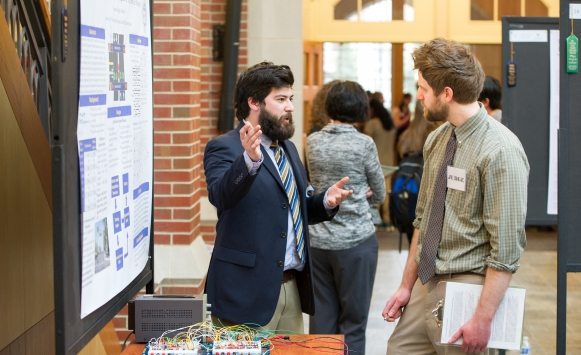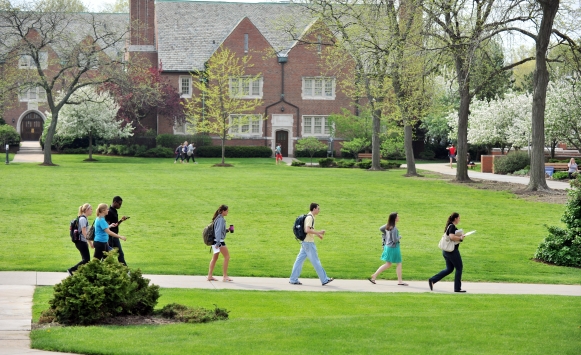Our programs are flexible, allowing you different options to reach your goals. The physics major is an excellent preparation for a diverse range of careers. For students interested in engineering, we offer both a four-year JCU degree in engineering physics as well as a 3-2 Dual Degree Engineering Program with Case Western Reserve University. Further, our majors pair well with minors in mathematics, computer science, entrepreneurship, and more.
Search
X Close
Department of Physics and Engineering
Centered on our Jesuit mission, the Department of Physics and Engineering teaches you how to think critically and solve problems like a scientist. Studying everything from the behavior of atoms to the physics of new materials in a liberal arts environment will give you a perspective that many other institutions can’t provide. In addition to your technical training, you’ll have superior oral and written communication skills that employers and graduate schools value.
- Department of Physics and Engineering Newsletter Fall 2024
- Department of Physics and Engineering Newsletter Spring 2024
- Scholarships
- Research and Internships
- Outcomes
Undergraduate
Major
If you're interested in engineering, you can participate in the 3-2 Dual Degree Engineering Program with Case Western Reserve University. You'll attend John Carroll for three years, then transfer to CWRU for two years and receive both a bachelor’s degree from JCU and a B.S. in Engineering from CWRU.
Learn MoreOur more general engineering program, this option is great if you're interested in pursuing engineering development, applied physics, or graduate study in related fields.
Learn MoreSelf-designed and flexible, the interdisciplinary physics major is ideal preparation for medical school, technical sales, or JCU’s five-year B.S./MBA program.
Learn MoreThe physics B.A. degree provides you with a comprehensive introduction to the discipline and the opportunity to explore some areas of physics in greater depth. It is appropriate if you are pursuing law school, want to teach at the high school level, or are interested in the 3-2 dual degree engineering program with Case Western Reserve University.
Learn MoreThe physics B.S. requires an in-depth study of the core areas of physics and a selection of upper-division courses such as thermal physics, atomic and molecular physics, condensed matter physics, or other engineering electives.
Learn MoreMinor
The physics minor provides students with a broad understanding of fundamental topics in both classical and modern physics.
Learn MoreDepartment Highlights
85%+
... of our students obtain at least one internship before graduation.
Internships
Example Cleveland-area science and technology firm placements include NASA, the Cleveland Clinic, General Motors, Lubrizol, Energy Focus, Photonics Developments, and Smartshape Design.
How & Why
Studying everything from the behavior of atoms to the physics of new materials in a liberal arts environment will give you a perspective that many other institutions can't provide.
Why JCU Physics
A physics or engineering physics degree is one of the most flexible, marketable, and respected degrees a student can achieve.
All of our majors carry out a significant research or design project under the guidance of a faculty member. Paid summer research positions are available to students through our Summer Undergraduate Research Fellowship program.
Physics can lead to quite lucrative careers, and the projected job growth rate for the field is very high. Example job titles of recent graduates include research engineer, medical physicist, product manager, quality inspector, and cryo-imaging technician.
You'll benefit from our faculty's broad range of research interests, including biomedical imaging research, green energy applications, and atomic and molecular physics.

"After graduation I spent a year teaching 8th grade Algebra at Saint Kateri Catholic Schools. I am currently in my final semester as a Master of Public Affairs and Master of Science in Environmental Science candidate concentrating in Energy at Indiana University's O'Neill School of Public and Environmental Affairs. I am spending my final semester reconnecting with my engineering physics roots at Delft University of Technology in The Netherlands. Throughout my time in this graduate program I have focused on the technology, policy, and economic factors impacting the Shale Gas Revolution and development of a sustainable energy future through the energy transition.
My time at John Carroll and the many lessons I learned have applied well beyond the world of Engineering Physics. The focus upon 'learning how I learn' has allowed me to quickly enter a new field and everyday I have used the problem-solving methods I learned at JCU to tackle complex problems. Following graduation from IU I am looking to enter the world of energy policy working in Washington, D.C., or Ohio."
"Physics is truly one of the coolest subjects anyone can study; it opens up so many career opportunities, it describes why the world works, and it is intellectually challenging and satisfying." Brian is currently pursuing his Ph.D. in Physics at Case Western Reserve University.
“Every college will promise to prepare you for a career, and John Carroll definitely will too. But that’s where most of them stop. JCU, on the other hand, won’t just make you more employable; it will help you become a better person. That’s the cura personalis — care for the whole person — part of the Jesuit philosophy. From the liberal arts core to service to spirituality, JCU really prepares you not just for a career, but for a life well lived. That’s something that may be undervalued in today’s society, but it’s incredibly valuable in the long run.” Spencer's first position, which he accepted before graduating from JCU, was as an engineer working in fire protection for a large engineering firm in downtown Cleveland. But when the opportunity of a lifetime came calling, Spencer moved into an electrical engineer position at NASA Glenn Research Center working on the Orion Mission, aiming to send people to Mars.

Department Colloquium
All seminars begin at 4 p.m. in Room E133 of The Dolan Center for Science and Technology.
"Probing the Free Carriers, Phonons and Band Electrons in Semiconductor Thin Films"
Frank Peiris
Department of Physics, Kenyon College, Gambier, OH 43022
In general, the information on free carriers, phonons and band electrons is stamped on the dielectric function of a material, and these entities dominate their signatures at different spectral regions. The talk will focus on how three spectrometers, which span a wide spectral region (i.e., 85 cm-1 and 50,000 cm-1), are used to decipher the dielectric functions of molecular beam epitaxy-grown Hg1-xCdxSe thin films. Initially, two spectroscopic ellipsometers were used between 400 cm-1 and 50,000 cm-1 to determine the dielectric function and the thickness of Hg1-xCdxSe films. Ellipsometry results were then used to model the reflectivity data, which allowed us to obtain the absolute reflectance values and to map the dielectric function from the reflectivity spectra, obtained between 85 cm- 1 and 8,000 cm-1 from the third spectrometer. By representing the dielectric function as a collection of classical oscillators, we were able to recover the details of absorption due to free electrons, phonons, and band electrons in the Hg1-xCdxSe alloy system. Besides the information on carrier concentration and band gap values, our models find two transverse phonon modes for Hg1-xCdxSe, where the HgSe-like mode blue-shifts and the CdTe-like mode red-shifts with increasing Cd concentration.
Reports from Summer 2020 Research at JCU, with speakers Caroline Kuzcek and Alec Coutris, JCU Undergraduate Researchers
Current JCU Physics Faculty Research Topics, with speakers Dr. Danielle Kara and Dr. Dinesh Shetty, JCU Physics Faculty
Stellar Transience and the Geometry of the Universe
Transient stellar phenomena have provided a rich lode of results from which we have been able to probe the structure and history of the universe. Relations between the period of variability and intrinsic luminosity of Cepheid variable stars led directly to the discovery of cosmic expansion and the Big Bang. In addition, they have revealed the presence of large amounts of dark matter dominating the matter density of the universe. Most recently, supernovae have provided a greatly needed probe to vast distances, and we have discovered a new dark energy which contributes the bulk of the energy density in the universe. I will review these results and discuss current outstanding questions. Recent research into supernovae and variable stars using the Robotic Optical Transient Search Experiment telescopes will be discussed, and an initial alternative measurement of the cosmic expansion in the local universe will be described. Measurements planned using the soon to start Dark Energy Spectroscopic Instrument will be discussed that will utilize the clustering of galaxies across most of the visible universe to provide a time history of cosmic expansion over the last 10-11 billion years.
It’s Only a Paper Moon
Presenter: Timothy Peshek, PhD
Affiliation: NASA Glenn Research Center, Photovoltaics and Electrochemical Systems Branch
One cool October morning in Cleveland I was presented with an interesting opportunity: a call for proposals for commercial lunar payloads was out, the response time frame was rapid, and the solicitation desired hardware that was nearly complete. I took the afternoon off, went for a long hike in a local park, and developed an idea, later to be known as the Photovoltaic Investigation on the Lunar Surface (PILS). I will recount the story of how a handful of photovoltaics researchers developed lunar hardware to probe the interaction of solar arrays and the lunar plasma environment, and what this project means for NASA, going forward. My goal is to convey the message that the paperwork was as challenging as the research and development, but made me a better scientist. In this telling, I will also present the fundamental physics of plasma interaction science, future directions in our research, and also motivate why thin-film solar cells may end up being the future of space power – if we can make them somewhere else.
Biomechanics of Dance: Spinning Tops and Pirouettes
Speaker: Dr. Melanie Lott
Affiliation: Department of Physics, Denison University
The human body is an incredibly complex machine, but useful information about human movement dynamics can be gained from simplified physical models. The simplest physical model of the body in an upright posture (e.g., standing on two feet) is that of an inverted pendulum, where the center of mass is located above a pivot point at the ground. In this model, balance is maintained by managing the torque due to gravity via the vertical alignment of the body’s center of mass and the center of pressure at the base of support. But how far do simplified physical models go when the motion becomes increasingly complex, for example, when the body rotates in an upright posture such as a dancer performing a pirouette?
In this talk, we will consider a theoretical model of a dancer spinning in a pirouette, much like a spinning top, to uncover the likelihood that dancers can achieve multiple revolutions in the pirouette without making postural adjustments. I will then discuss the results of experimental studies, in which high-speed motion capture equipment was used to collect time-series data of body segment positions and orientations during pirouettes and how principal components analysis was used to identify joint angle coordination strategies that dancers utilize to maintain balance while rotating.
Please join us as our Seniors present their Final Presentations:
Amanda McGreer, "Quantifying the behavior of Monosodium Urate Crystals in a Magneto-Optical Device"
Chase Waterman, "Measurement and Calculation of the Extinction Coefficient of MSU Crystals using the Magneto-Optical Device"
Isaac Kozak, "Advanced Terrain Manipulator for Organized Sample Preparation and Handling for Evaluation or Research of Europa (ATMOSPHERE)"
Jude Haddad, "Advanced Terrain Manipulator for Organized Sample Preparation and Handling for Evaluation or Research of Europa (ATMOSPHERE)"
Topic: PH-408-51 SP21: Final Presentations
Time: May 13, 2021 01:00 PM Eastern Time (US and Canada)
Join Zoom Meeting
https://johncarrolluniversity.zoom.us/j/96718733403
Adding Piano Notes
Speaker: Dr. Jutta Luettmer-Strathmann
Affiliation: Department of Physics, University of Akron
Many contemporary composers use virtual instruments on digital audio workstations to create and record music. However, real instruments exhibit physical phenomena that can be difficult to reproduce digitally. In this work, we focus on the piano and explore a nonlinear effect that occurs when two notes are played at the same time. The effect is due to soundboard vibrations which lead to a net interaction between strings of simultaneously played notes. When two notes are combined on a virtual instrument, the software adds the signals of separately recorded samples and does not account for these nonlinear interactions. To investigate simultaneously played and software-added piano notes, we perform simulations of a piano model that describes soundboard, strings, and hammers and is solved with finite difference methods. The model combines realistic parameters for materials with a simplified soundboard geometry with the aim of generating relevant results within reasonable computational effort. We simulate the playing of separate notes, which are added as one might do with composing software, and of simultaneous notes. An analysis of the resulting power spectra and decay times shows measurable differences between simultaneously played and software-combined notes. The audience is invited to judge if these differences can be noticed by a listener.
Reports from JCU Summer Research
Presenters:
Caroline Kuczek:
Simulating Cepheid Stars
Victoria Marino:
Exploring the Photoconductive and Thermoelectric Effects of MAPB(3)
George Pantelimon:
The Study of the Period - Luminosity Relation of Variable Stars
Michael Roth:
Hall Mobility and Carrier Concentration of ZnSnN2--
The Nobel Prize in Physics 2021
Speaker - Dr. Anthony Roy Day
The Nobel Prize in Physics 2021
… was awarded awarded "for groundbreaking contributions to our understanding of complex systems" with one half jointly to Syukuro Manabe and Klaus Hasselmann "for the physical modelling of Earth's climate, quantifying variability and reliably predicting global warming" and the other half to Giorgio Parisi "for the discovery of the interplay of disorder and fluctuations in physical systems from atomic to planetary scales."†
This seminar will introduce complex systems by focusing on Giorgio Parisi’s work on spin glasses. The spin glass is a simple model system that has a rich solution structure and understanding this structure has provided a roadmap for understanding complex systems in general. I will review the spin glass model and its physical realizations, outline how Parisi solved the model, and describe the special features of his solution. The seminar will conclude with a brief overview of how concepts from spin glasses have been applied to other complex systems.
Laser Spectroscopy of Rare Gases
Speaker - Dr. Naveed Piracha
This talk is an overview of our work in the field of laser spectroscopy of rare gases. We have designed different experimental techniques to gather information on the atomic structure and discharge mechanism of these gases. The development of this knowledge leads to applications in the fields of analytical chemistry, material engineering, plasmas and upper atmosphere.
Ga2O3: A Promising New Ultra-Wide Bandgap Semiconductor
Speaker - Jon P. McCandless
Since the seminal work by Higashiwaki, et al., in 2012, β-Ga2O3 has gained attention due to its large bandgap (~4.7 eV), the availability of large-area native substrates, and the ability to achieve multi-order electrical conductivity change through n-type doping.1 The large bandgap and corresponding large critical field strength make it particularly appealing for high-power and high frequency applications. Additionally, Ga2O3 is polymorphic. The metastable α-phase – which take on the corundum structure – is of interest due to its larger intrinsic bandgap (~5.3 eV) and the ability to readily alloy it with Al – reaching bandgaps up to 8.8 eV.
Molecular beam epitaxy (MBE) is a growth technique which can form sharp interface and control single atomic layers of atoms, making this particularly suited for the growth of quantized heterostructures. Despite the benefits of MBE, there are several challenges in Ga2O3 growth. The growth kinetics and thermodynamics of MBE result in doping challenges for both the β- and α-phases. Additionally, the growth of α-Ga2O3 is challenging due to the metastability of the phase and the tendency of it to revert to the monoclinic β-phase.2 In this talk, I will introduce and motivate Ga2O3 and will discuss my efforts in the stabilization and doping of both the α- and β- phases.3
1 M. Higashiwaki, et al., APL, 100, 013504 (2012)
2 J. P. McCandless, et al., APL, 119, 062102 (2021)
3 J. P. McCandless, et. al., ICMBE, Puerto Vallarta, Mexico, (2021)

